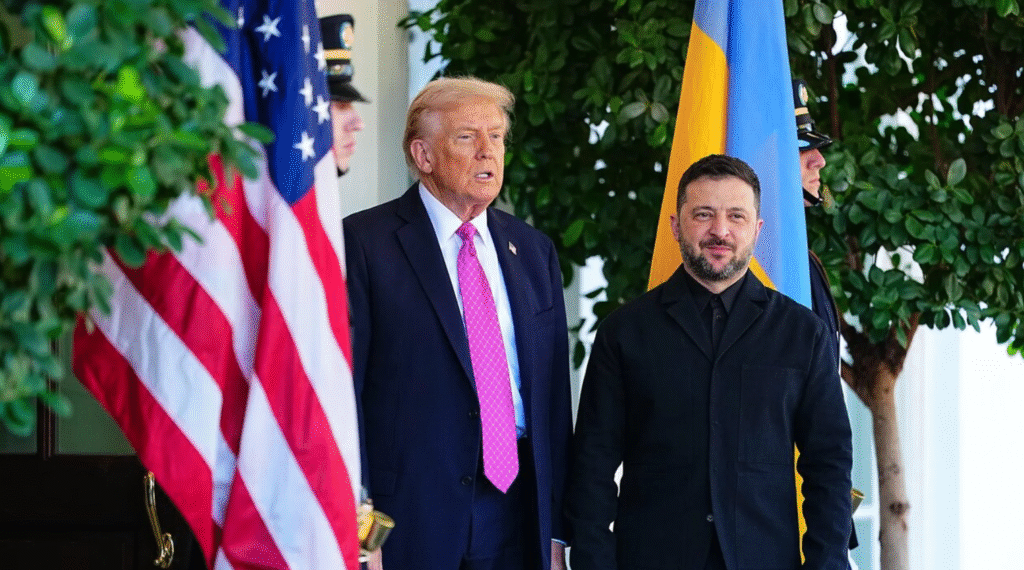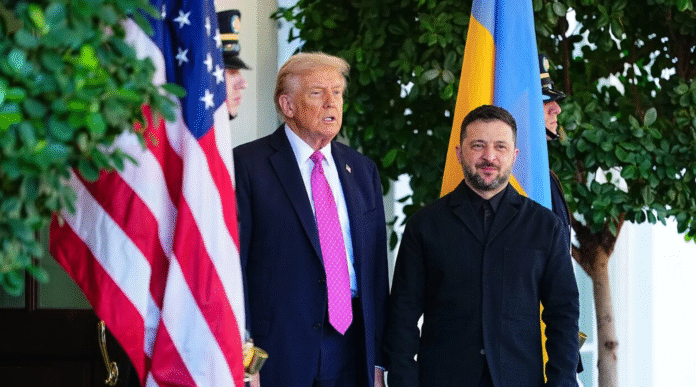Zelensky Fails to Secure Tomahawk Missiles from Trump Amid Ongoing Conflict
Ukrainian President Volodymyr Zelensky left Washington this week without a firm commitment from U.S. President Donald Trump to supply Tomahawk cruise missiles, a decision that could shape the next phase of the war in Ukraine.
During the White House meeting, Trump appeared hesitant, stressing that the U.S. was “not ready” to provide long-range missiles that could escalate tensions with Russia. Zelensky later admitted that while discussions on advanced weapons took place, both sides agreed to remain silent publicly “because the United States does not want an escalation.”
The Zelensky fails to secure Tomahawk meeting followed Trump’s recent call with Russian President Vladimir Putin, with whom he agreed to meet soon in Hungary. This timing raised eyebrows among Western observers and Ukrainian officials alike.

Zelensky Fails to Secure Tomahawk: A Diplomatic Setback for Kyiv
For months, Ukraine has sought Tomahawk missiles as a strategic tool to cripple Russia’s vital oil and energy infrastructure. Zelensky believes such strikes could disrupt Putin’s war economy and shift the conflict’s momentum.
Trump, however, described the request as “a big deal,” suggesting that the U.S. needs the missiles for its own defense priorities.
“Hopefully, they won’t need it. Hopefully, we’ll end the war without thinking about Tomahawks,” Trump said, hinting that peace could be achieved without further escalation.
While the Zelensky fails to secure Tomahawk outcome disappointed Kyiv, Trump maintained that discussions would continue.
Trump’s Message to Putin: ‘Stop Where You Are’
After the meeting, Trump took to Truth Social to call for both Kyiv and Moscow to “stop where they are” and begin peace negotiations. His statement mirrored his earlier conversation with Putin, where both leaders agreed to “meet soon” to discuss a possible truce.
When asked by BBC News if Putin’s willingness to meet was influenced by the threat of U.S. missiles, Trump responded, “The threat of that is good, but the threat of that is always there.”
Trump’s approach, maintaining pressure without direct military aid, reflects his desire to balance diplomacy and deterrence while avoiding deeper U.S. involvement.
Ukraine’s Realism and Trump’s Pragmatism
Zelensky, ever the realist, told reporters he understood the U.S. hesitation but insisted that Ukraine must remain ready. “We have to stop where we are. The president is right,” Zelensky said, acknowledging Trump’s push for an interim ceasefire.
When asked if Putin truly wants peace or is simply buying time before the Budapest meeting, Zelensky replied cautiously, “I don’t know.”
Despite the Zelensky fails to secure Tomahawk setback, the Ukrainian leader maintained a diplomatic tone, emphasizing that his goal remains “to protect as many lives as possible and strengthen security in Europe.”
Allies React: UK and Europe Back Ukraine
Following the Washington meeting, Zelensky called several European leaders, including UK Prime Minister Keir Starmer, to brief them on the discussion with Trump. Starmer described the conversation as “productive” and reaffirmed that the UK would continue military and humanitarian support for Ukraine.
Meanwhile, other European nations have urged Trump not to compromise too early in his talks with Putin, fearing it could embolden Russia to solidify its control over occupied territories.
External observers, such as the International Crisis Group and Council on Foreign Relations, have highlighted that Trump’s cautious stance could mark a shift in U.S. foreign policy toward a more isolationist approach.

Zelensky Fails to Secure Tomahawk: Putin’s Strategic Advantage
As Zelensky returns home, Putin appears to be positioning himself for new negotiations from a position of strength. The planned Budapest summit could reshape the future of the war, especially if Trump prioritizes diplomacy over weapons supply.
When asked if he feared Putin was “playing for time,” Trump replied,
“I’ve been played all my life by the best of them, and I came out really well… I think he wants to make a deal.”
Still, Trump admitted that there was “bad blood” between Putin and Zelensky but insisted all three leaders “have to get together.”
Human Cost and Hope in Ukraine
Back in Ukraine, the reality of war remains harsh. In a Kyiv suburb, residents like Volodymyr, who lost his store to a Russian missile strike, rebuild with resilience. When asked about Trump’s talks with Putin, he paused before saying, “Truth and democracy will win… we just want to live.”
This sentiment reflects the growing fatigue and hope among Ukrainians, a desire for peace but not surrender.
As Zelensky fails to secure Tomahawk support, Ukraine continues to rely on its Western allies for defensive weapons, drones, and humanitarian relief.
The Bigger Picture: Diplomacy vs. Defense
The Zelensky fails to secure Tomahawk episode underlines the fragile balance between diplomacy and deterrence. Trump’s reluctance to arm Ukraine further signals a cautious optimism that peace might still be negotiated, but also raises fears that Kyiv may face future offensives without critical U.S. firepower.
For Zelensky, the message is clear: Ukraine must strengthen alliances, diversify its defense sources, and prepare for diplomacy shaped by unpredictable partners.

